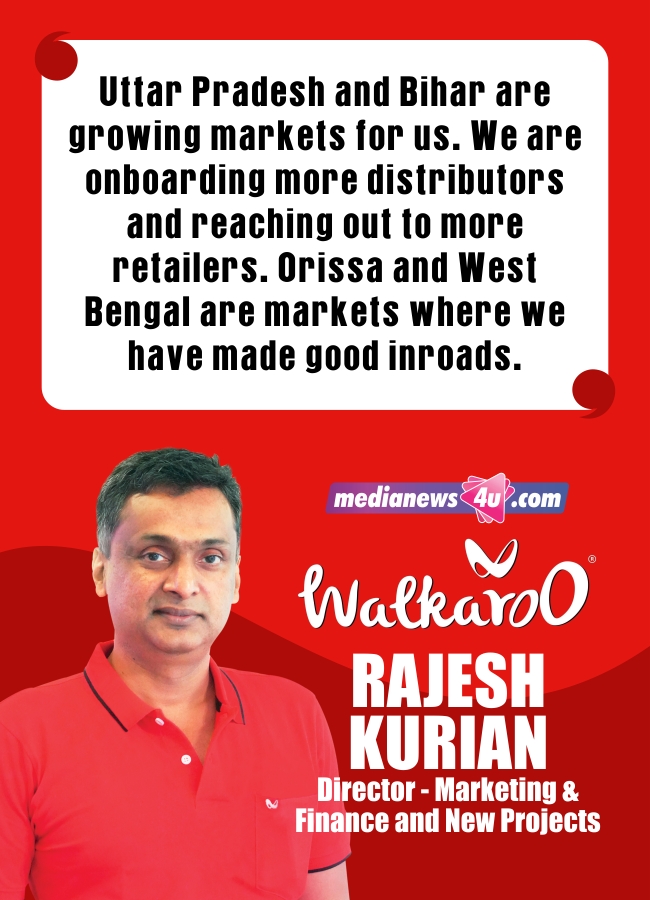You have said two-thirds / 70pc of revenue is from South India and a topline of Rs.2,100 crore was expected this FY (up from Rs.1,850 cr). You have created national campaigns with Aamir Khan and now roped in Ajay Devgn. How has the non-south share grown?
Two-thirds of Walkaroo’s sales come from South India. Among the rest, north and east are faster growing markets for the brand. Four or five years back, the south contributed 80pc of the revenue. Now it’s somewhere around 65pc and north, east and west together contribute 35pc. As the distribution penetration is increasing in the north and east, we are expecting it (non-south share) to be 40pc in the coming years.
Uttar Pradesh and Bihar are growing markets for us. We are onboarding more distributors and reaching out to more retailers. Orissa and West Bengal are markets where we have made good inroads.

We roped in Ajay Devgn to connect to the North Indian consumers as he is a familiar face especially among Tier 2, 3 cities and has mass appeal.
Rs.2,100 crore was the number we were targeting to achieve. We should be able to achieve close to Rs.2,000 crore.
Reports also say you are present in 1.5 lakh retail outlets through 750 distributors. How much of these are in the south now and how many new outlets will come up in the north?
Numbers vary year on year. We are in the process of updating the numbers. A larger share, around 60 to 65pc of the outlets are in South India. There is a similar demand for the products in other markets which we are working on.
From the current 5pc market share, where do you expect to reach by, say, March 2024?
Going by the per capita consumption, India has footwear consumption of around 200 crore pairs annually. Walkaroo manufactures 12 crore pairs per year and from that we assumed that our market share would be around 5pc. In another two years we expect it to grow to 6pc.
The largest selling items are said to be of slippers priced around Rs.300. What percentage do each – slippers, kids footwear, women’s footwear, sports shoes and formal shoes contribute?
Across the footwear market the split would be 55pc gents and 45pc from ladies. Our share would be 60 to 65pc skewed towards gents and close to 30pc ladies and 5pc from kids.
Being a South Indian company, Walkaroo is a late entrant to the sports shoes category. In the south the demand for open footwear is high as they don’t have winter. In northern markets, post Diwali there is a shift from open footwear to closed footwear. Though we are a late entrant, the product has picked up well in both North and South Indian markets.
You are doing activities around the FIFA World Cup. You also sponsor marathons. Tell us about the non-advertising promotions and associations. What are they aimed at?
We are looking at more and more customer engagement activities. During the ICC T20 Men’s World Cup we did a customer engagement activity, where they could play games and win prizes. We achieved 10 lakh customer engagements through the activity. We are doing a winner prediction competition for the FIFA World Cup.
Recently, we have conducted a marathon in Coimbatore, the ‘Walkaroo Coimbatore Marathon’ where more than 60,000 people participated. These kinds of activities give good visibility to the brand.
From a brand point of view, we advertise saying ‘Walk with Walkaroo’. Walking is a solution for many kinds of health issues like obesity and lifestyle diseases. We are also trying to engage with consumers with this brand point of view.
Of the marketing / media spend, what is the share of digital and how is this growing?
We engage consumers across TV, print, BTL, and digital. We invest 30pc in TV. Print’s share was close to 30 to 35pc a few years back; it has now dropped to 15 to 16pc or less.
Digital contribution has increased over the years. Earlier it was 5pc, now it has doubled to 10pc.
What is the brand’s e-commerce play? How much do marketplaces contribute? Is what sells online different from what sells offline?
We are on major platforms like Amazon and Flipkart. We are a late entrant to the e-commerce category.
There are issues faced by mass products on e-commerce platforms. The shipping cost for instance is a volumetric cost. Footwear comes in a box and even though the weight would be 200 to 300 gms, it will be considered as 1 kg (for calculating shipping cost). The volumetric shipping cost and the platform cost are fixed costs. So invariably you need to sell products at a higher price to achieve profit.
We have a portfolio of offerings in the range of Rs.300 to Rs.1000, but a larger share would be between Rs.350 and Rs.400. It is not very attractive to sell low value products on e-commèrce platforms.

















